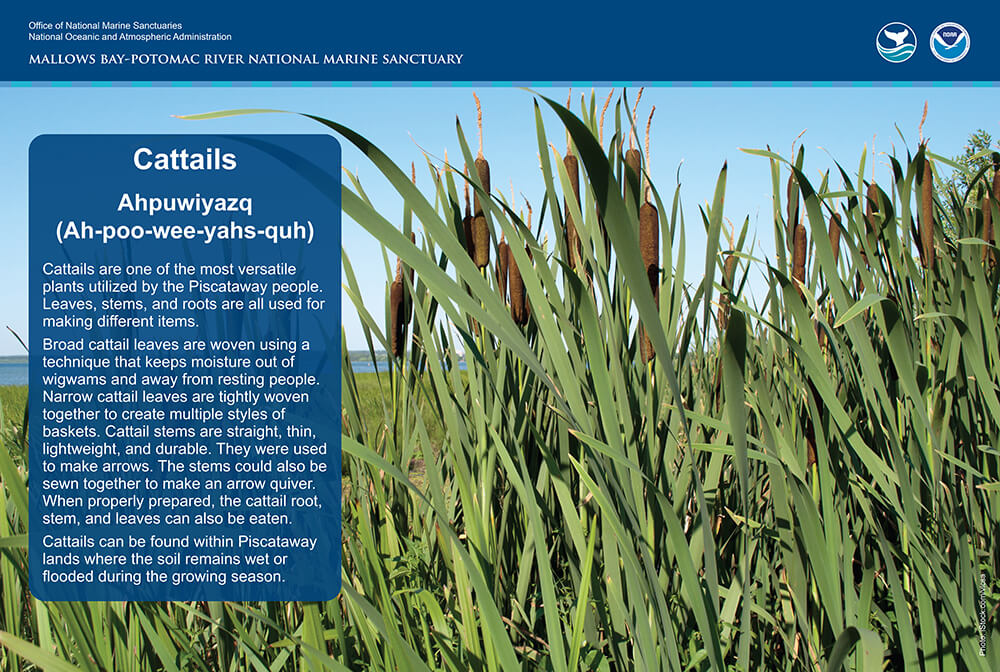Cattails - Ahpuwiyazq - (Ah-poo-wee-yahs-quh)

Cattails are one of the most versatile plants utilized by the Piscataway people. Leaves, stems, and roots are all used for making different items.
Broad cattail leaves are woven using a technique that keeps moisture out of wigwams and away from resting people. Narrow cattail leaves are tightly woven together to create multiple styles of baskets. Cattail stems are straight, thin, lightweight, and durable. They were used to make arrows. The stems could also be sewn together to make an arrow quiver. When properly prepared, the cattail root, stem, and leaves can also be eaten.
Cattails can be found within Piscataway lands where the soil remains wet or flooded during the growing season.
A Further Piscataway Perspective
Cattails are found across Turtle Island (North America). There are two types of Cattails, the Common (broad-leaf) Cattail grows mainly in shallow freshwater; whereas the Southern Cattail (a narrow-leaf version) ranges into brackish water and thrive in deeper water. Cattails flourish in any area where the soil remains wet or flooded during the growing season, including wetlands, marshes, ponds, and shorelines. It was used in so many ways by our ancestors that we view this plant today as the “Swiss Army Knife of Plants.”
Our ancestors harvested the broad-leaf Cattail to make a variety of woven mats. Using an assortment of weaving techniques, mats were woven to create covering for our Wigwams (portable, short-term housing); for bedding or sitting (mats were used to sleep upon in order to create a moisture barrier with the ground); or to place cooked food upon during family meals or tribal celebrations. Some mats were carefully woven with elaborate designs. Our ancestors could begin to harvest the Cattails for its leaves from mid-June to late September while the leaves were pliable. In order to create a tight weave into the mats, much of the natural moisture had to be removed from the Cattail leaves. To do this the Cattail leaves were separated from its stem and laid upon the ground in the shade for several days, until much of the moisture within the leaves evaporated, yet the leaves were still flexible. The leaves are wide and foamy, and wide enough to be sewn through when making the mat. Such foamy leaves also act as built in insulation, and the leaves’ shape naturally guide water down and away from the lodge. These mats had short life-spans when used on the exterior of the lodge which is believed to be about 3 years.
Cattails provided an abundant food resource all year round. Almost every part of the plant can be consumed at different stages. In the spring, the young shoots can be eaten before the flower forms. Our ancestors would simply peel the outer leaves back to find the sweet, juicy inner “heart”. In early summer, the immature flower heads can be consumed. These must be boiled or steamed and have a flavor similar to that of corn. During the fall and winter, the plant survives on a store of starch in the root. These can be dug up, cleaned, and the starch extracted from them with water.
The Southern Cattail provided another source for making cordage (string or rope) or weaving baskets. To make cordage, our ancestors pounded or shredded the cattail leaves and then soaked them to further separate the fibers. Once this was completed they either braided, or twisted strands together by rubbing them on the top of the thigh with the palm of the hand.
Cattail Shoots and Season Change at Mallows Bay Park
Anjela Barnes (Piscataway), Executive Director, Accokeek Foundation at Piscataway Park, discusses cattails growth and season change at Mallows Bay Park in Nanjemoy, Maryland. Credit: National Marine Sanctuary Foundation, Accokeek Foundation, NOAA.
Cattail Importance in the Piscataway Culture
Tiara Thomas (Piscataway), Education and Interpretation Director, Accokeek Foundation at Piscataway Park, summarizes the importance of the cattail to Piscataway culture. Credit: National Marine Sanctuary Foundation, Accokeek Foundation, NOAA.
Cattail Use in Fishing Weirs
Tiara Thomas (Piscataway), Education and Interpretation Director, Accokeek Foundation at Piscataway Park, summarizes the Piscataway’s use of cattails in building fishing weirs. Credit: National Marine Sanctuary Foundation, Accokeek Foundation, NOAA.
Cattail Use in Woven Baskets
Tiara Thomas (Piscataway), Education and Interpretation Director, Accokeek Foundation at Piscataway Park, summarizes the Piscataway’s use of cattails in building decorative and functional woven baskets. Credit: National Marine Sanctuary Foundation, Accokeek Foundation, NOAA.
Cattail Use in Bow and Arrow Quivers
Tiara Thomas (Piscataway), Education and Interpretation Director, Accokeek Foundation at Piscataway Park, summarizes the Piscataway’s use of cattails in building bow and arrow quivers. Credit: National Marine Sanctuary Foundation, Accokeek Foundation, NOAA.
Cattail Use in Arrow Construction and Different Kinds of Arrowheads
Tiara Thomas (Piscataway), Education and Interpretation Director, Accokeek Foundation at Piscataway Park, summarizes the Piscataway’s use of cattails in arrow construction and how the Piscataway used different types of materials over time to create their arrowheads. Credit: National Marine Sanctuary Foundation, Accokeek Foundation, NOAA.
Cattail Use in Building Covers for a Wigwam
Tiara Thomas (Piscataway), Education and Interpretation Director, Accokeek Foundation at Piscataway Park, summarizes the Piscataway’s use of cattails in building covers for a wigwam. Credit: National Marine Sanctuary Foundation, Accokeek Foundation, NOAA.
Cattail Use in Constructing Bedding and Sitting Mats
Tiara Thomas (Piscataway), Education and Interpretation Director, Accokeek Foundation at Piscataway Park, summarizes the Piscataway’s use of cattails in building bedding and sitting mats. Credit: National Marine Sanctuary Foundation, Accokeek Foundation, NOAA.
Cattail Use in Constructing Food Service Mats
Tiara Thomas (Piscataway), Education and Interpretation Director, Accokeek Foundation at Piscataway Park, summarizes the Piscataway’s use of cattails in building food service mats and shows several woven cattail food baskets as well. Credit: National Marine Sanctuary Foundation, Accokeek Foundation, NOAA.

